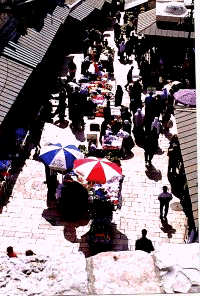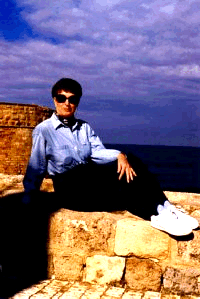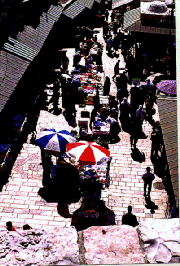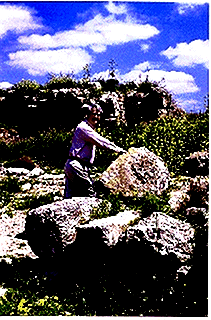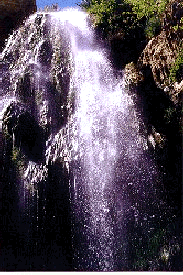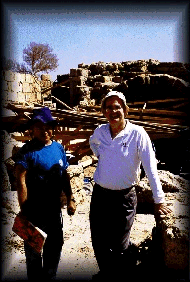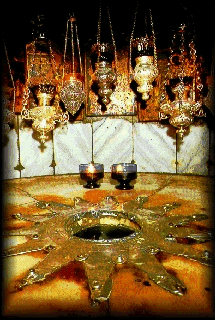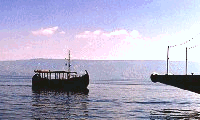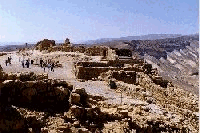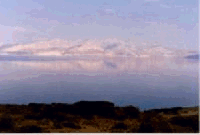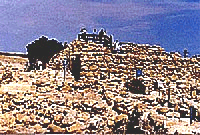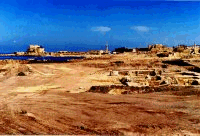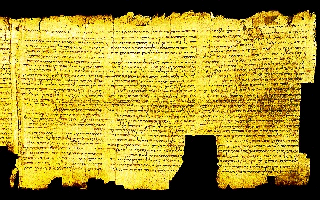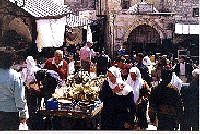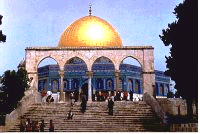A Land of Different Things to Different People
To Mike, a return to another life time
To Me an experience to be remembered for a life time
Well here it is . . . the long awaited letter about our trip to Israel. These always take a while to get started because there is so much to say.
Left San Diego Tuesday, March 7th. We traveled from San Diego to Dallas/Fort Worth, through Gatwick, England and into Tel Aviv by 5:00pm Israel time Wednesday. There is a 10 hour time difference between San Diego and Israel. We encountered more security in England than anywhere else on our trip going or coming. Every security check point in Europe insisted that film goes through the x-ray machines! No arguments and so in it went and I figuratively held my breath.
Israel has changed in many ways since Mike was there 20 years ago. We arrived at Ben Gurion Airport, checked out our rental car (An Avis/Mazda:Just a little run about) and headed for the general direction of our Kibbutz . . . Shefayim located just north of Tel Aviv. In due time, with a few extra twists and turns, we arrived and checked in and COLLAPSED!
All of our accommodations included breakfast so on Thursday morning, we joined the residents (and attendees at a conference) in the dining room at the appointed hour for our breakfast buffet. Fresh fruit, orange juice, grapefruit juice, eggs, pickled and smoked fish (not my favorite although I did “nibble” a bit) breads, cheeses, a mixture of diced cucumbers and tomatoes (a favorite faire at every breakfast). Our biggest problem was getting to the dining room and eating ahead of the smokers (oh yes if you don’t smoke, Europe and the middle East can present problems).
In early civilizations destroyed and rebuilt, there is a layering effect where new buildings were built over the old ones. Hence the various civilizations and eras can be reflected in the sizes and types of stones that make up the walls of the city, the shops and houses.
On Thursday morning we headed for Caesarea. The site was first occupied by the Phoenicians, who built a harbor here in the 4th Century B.C. Herod the Great began construction of a large city named in honour of Augustus occupied by both Jews and non-Jews. When Judaea became a Roman province Caesarea was, from AD 6, (or as called in Israel CE for Christian Era) the residence of the Roman procurators including Pontius Pilate during whose term of office Christ was crucified. The Crusaders occupied this town in 1101. The crusader fortress has been open to the public for many years. The remains of an aqueduct are present here and you could see how the citizenry of the time got their water from inland sources.
It was at this site that Mike was photographer in 1972. He was often the first into various “digs” in order to take pictures before disturbing the artifacts. Mike introduced himself to the Head Archeologist (Daveed) who was happy to talk to someone who had been present in the first season of the dig. We were then taken on a “guided tour” of this ongoing archeological dig. During Mike’s time at the dig only a very small section of the Herodian city had been unearthed. Now, 20 years later, a large portion of the city has been uncovered. They are working diligently to have the site open for tourists by 1998 – the 50th Anniversary of Israel as a nation. We spent several hours there touring the site, taking pictures and eventually enjoying a wonderful lunch sitting in a restaurant overlooking the Mediterranean. Our second night at Shefiyam we went in search of supper and came across an Israel equivalent of a Dennys. Kapulsky’s. They seemed to serve a little bit of everything, were located throughout Israel, (I got to the point where I could even read the word in Hebrew!) and provided the most wonderful desserts: eclairs, apple strudel, etc.
On Friday, we packed up and slowly made our way northward to the Sea of Galilee and the town of Tiberias via Nazareth. (That included a false start when we tried to head through the Arab town of Tulkarm and discovered there were NO road signs to show the way after you hit the center of the city so we back tracked). After leaving Nazareth we passed through Cana. Cana was the little town famed as the place where Jesus performed his first miracle: the changing of water into wine at the Marriage in Cana of Galilee. We didn’t really stop in Nazareth (the largest Arab town in Israel) but had a pleasant journey over hill and dale through a time that has changed mightily over 2000 years.
Herod Antipas founded the city of Tiberias in AD 17 and named it after the Roman Emperor Tiberius. The town is very much like a seaside town with lots of shops and fish restaurants as their fish is still caught from the Sea of Galilee. We passed through Tiberias and Midgal (home of Mary Magdalene). Just north of Tiberias was our second Kibbutz – Nof Ginnosaur. This was a delightful place with green grass, trees and a wonderful scent from the citrus groves surrounding the property on three sides. Our room overlooked the Sea of Galilee in a peaceful setting. Oh yes, the breakfast dining room at Nof Ginnosaur was very different from Shefayim. Here, we only shared our meals with other tourists and there were lots of those. They brought them in by the bus loads each night. For a “small” kibbutz, there were about 7-10 buses there both nights.
On Saturday, we made our way toward Capernaum at the north end of the Sea of Galilee. (This is 673 ft. below sea level) It was here that Jesus called his first disciples: Simon Peter, his brother Andrew, James and his brother John. The town was first established around the 2nd century BC. The residents at Capernaum did not take part in the uprisings against Rome in the 1st and 2nd centuries. Here we visited a sort of archaeological park with many carved architectural fragments and mosaics. Straight across from the entrance, toward the back, is the Octagon of Peter where there are remains of earlier houses laid out in regular square blocks (insulae) the oldest of which dates from the 1st century BC. These were modest dwellings with small rooms surrounding a courtyard. One house was replastered at least three times and on the remains of plaster were found 131 inscriptions in which the names of Christ and Peter frequently occur. To its left is the synagogue that was partially rebuilt. It is hoped that further excavations on this spot will reveal the synagogue where Jesus taught. We left Capernaum (amid the tour buses) and traveled around the Sea with the Golan Heights on our left and the Sea at our right and passed over the River Jordan as it feeds into the Sea of Galilee. The fields where filled with yellow and red wild flowers, numerous citrus groves and farm land.
As we came around the Southern tip of the Sea we encountered Yardenit which is a place of baptism on the River Jordan south of Tiberias. The baptismal areas were built in recent years.
Sunday we headed to Jerusalem by way of Akko (Acre) (West then South) on the northern coast if Israel on the Mediterranean. It was here that I discovered just how much of an archaeological snob Mikey is! Akko was Palestine’s leading port and it has preserved an abundance of remains dating from the Middle Ages (not old enough for Mikey). Akko itself goes back to the Canaanite period with recent findings that suggest it may have been occupied as early as 3000 BC. One of the “highlights” is a crusader castle which was used by the British as a prison during the late 1940s and early 1950s. Very dismal place. Bad enough to think of it being a place to live 500 years ago – – but very depressing as a prison. We arrived in Jerusalem and finally found our hotel. Instead of the older structure we anticipated, we found that the Hyatt Regency is now relatively new and very modern. The hotel had several elevators one of which was a Shabbat elevator. It was programmed for Friday Night/Saturday to run automatically and stop at each floor. Pressing an elevator button, thereby causing a spark of electricity (fire) is considered work and work is not done on the Jewish Sabbath. The room itself had a drawer with a touch panel on it between the beds that controlled the radio/tv/lights/clock. The clock was also a Shabbat clock and could be programmed to turn the lights on and off at the appropriate hours.
Monday we ventured into the Old City of Jerusalem via shuttle from the hotel. It is a magnificent place. Words and pictures really cannot describe the experience of the Old City. It is very humbling to walk where Jesus and Mohammed walked and try to picture that time. During our week in Jerusalem we visited the Holy City many times, people watched at the Damascus gate (saw women in full Arab dress, tourists, men in partial Arab dress (Kafeiah – Headdress), women in partial Arab dress, merchants, (selling mint leaves and leaf lettuce), police, military, transporters of goods (the people who brought the food, furniture, trinkets, clothing, etc. into the Old City by way of donkey, handcart, horse drawern cart and small tractor) etc., drank lots of fresh squeezed orange juice and ate good food.
Jerusalem was once capital of the Jewish kingdom and is now capital of the state of Israel and the seat of a Greek Orthodox, an Armenian and a Roman Catholic Patriarch and the sea of the Anglican bishop. It is revered by Jews, Christians and Muslims alike and its status as a holy city is uniquely reflected in the many holy places sacred to the three great religions. Archeological finds show that the site was occupied by man in the Palaeolithic period. The walls of the Old City were built in 1537 by Sultan Suleiman the Magnificent. The City is divided into sections: The Muslim Quarter, Jewish Quarter, Armenian Quarter and Christian Quarter.
We wandered the Old City, poked our heads into various shops in the Arab Suq (market). These markets ranged from full size shops to literally small “holes in the wall” (that is truly a stone wall). Here the people of the Old City and surrounding new city come to shop for their every day needs – meats, fruits, vegetables, nuts (bought lots of cashews) clothing, etc. Here we got our T-shirts as well as one for Brittany and James and the Menorah for Barbara.
During our first day we entered through the Jaffa gate walked along the top of the walls and descended at the Damascus Gate. Here is the start of the Arab Market with their colorful array of fruits and vegetables. We made the acquiantace of an Arab shop keeper and talked for some time about living conditions in Israel and particularly the Old City for the Arabs and life and miscellaneous stuff. Mike impressed him with his “little bit” of knowledge in Arabic and it was like we fit right in. (We later came back to the shop to buy the Menorah and my Crusader Cross and were treated to fresh orange juice and mint tea).
The Western Wall (known as the Wailing Wall) is the holiest Jewish Site. This massive stretch of wall is part of the remaining wall on the southwest side of the Temple mount. The open space in front of the wall was originally crowded with shops and homes but was these were torn down in 1967. The section of this area nearest the wall has been railed off and it ranks as a synagogue with men praying to the left and women to the right separated by a railing. Religious ceremonies take place here (like the Bar Mitzvah we witnessed) and military is sworn in here. It is here that the Jews mourn the destruction of their Temple. We passed through security check points getting to and from the Western Wall. Just had to open the purse and tote bag as we passed by.
The Temple Mount just east of the Western Wall is the holiest place on earth for Jews. Nowhere else do the holy places of the three world religions lie so close together as here. It is sacred to both Jews and Muslims and is important to Christians as well for it was here that the infant Jesus was presented in the Temple, which the twelve year old boy disputed with the scribes and where he later cast out the merchants and money changers. It was here that the Temple was built in the four years of Solomon’s rein (950 BC).
Here is also the Dome of the Rock, one of the greatest of Muslim monuments. The original building was constructed in
705 (CE in Israel means Christian Era). In the center of the building of the inner rotunda is the Holy Rock over which the Jews’ alter for burnt offers may have stood. In Jewish belief the rock marks the spot where Abraham prepared to sacrifice Isaac while the Muslims believe that it was from here that Mohammed ascended into heaven. Under the rock is a cave known to Muslims as the Well of Souls where it is believed that the souls of the dead gather to pray.
The shifting boundaries over the centuries of the Old City of Jerusalem gives credence to the traditional location of Golgotha and the Tomb.
The Church of the Holy Sepulchre is one of the most sacred places in Christiandom. It is built on the site of Christ’s crucifixion and his tomb. It is a church of moderate size surrounded by a confused huddle of other structures. The Romans originally built a temple of Venus over the tomb and erected a statute of Jupiter on Golgotha (Calvary). When the Empress Helen, Constantine the Great’s Mother visited Jerusalem in 326 Bishop Macarius gave her information on the whereabouts of the tomb and Mt. Calvary and it was then that Hadrian’s temple was replaced by a new church that became the central monument of Christiandom.
The removal of the Roman temple and the terrace on which it stood revealed a tomb hollowed out of the rock, the hill of Golgotha and to the east an underground Roman cistern into which a number of crosses used for executions had been thrown. Helen identified one of these as the True cross on which Christ had been crucified and it became one of the holiest relics in the Christian world. The top of the hill was then leveled by the removal of the soil to provide a level surface for building leaving the Holy Sepulchre and Golgotha as projecting rocks. The Church of the Holy Sepulchre was built over all of this. The ownership of the church is shared by six religion communities: Greek Orthodox, Roman Catholics, Armenians the Copts, the Syrians and Abyyssinias.
To the right of the entrance to the Church is a flight of steps leading up to Golgotha (Mount Calvary) where a rock rises above floor level. Here we find two chapels richly decorated with mosaics. The first is the Roman Catholic chapel. To the left, behind bullet proof glass can be seen the rock in which the Cross is believed to have been set. (Greek). We passed the Stone of Unction on which Christ’s body was laid and anointed after his crucifixion. Then we come to the Rotunda of the Holy Sepulchre. The structure of the tomb conceals the natural rock which can be seen only in the Coptic chapel to the rear of the sepulchre. In the antechamber is a stone on which the angel who announced the resurrection of Christ to the holy women is said to have sat. It is probably a remnant of the round stone which closed the mouth of the sepulchre and was rolled away by the angel. The low door leads into the small tomb chamber. Along the right-hand wall of which is a marble slab marking the empty burial place.
We saw the Cardo (Mall) (25 ft. below ground) and followed it through a variety of Jewish Shops and looked at the remains of more of the old city (another 15 ft. below the Cardo level). We sampled fresh orange juice at every opportunity. (In fact the entire country is loaded with small places where you can purchase fresh squeezed OJ (and I don’t mean Simpson – boy that was a relief – three weeks without that OJ). The local inhabitants would cut the oranges and squeeze them right there in front of you. There was no question that was what you were getting. We found a small used bookstore just inside the Zion Gate and several times swapped our used books for other used books. This saved us from having the transport lots of books around on the airplane and in the country.
We visited the Israel Museum which is the site of the Shrine of the Book. Here in this white domed building (looking like the lid of a 2000 year old pottery jar) are housed the Dead Sea Scrolls. The scrolls were found from 1947 onwards in caves around the monastery of the Essenes at Qumran (which we later visited) and were eventually acquired for Israel. The scrolls are the earliest manuscripts of the Old Testament in the Hebrew Language apart from two silver tablets engraved with a few works from the book of Numbers. In the rotunda are displayed scrolls containing extensive passages from the book of Isaiah (copies). These were written about 100 BCE (Before Christian Era). They show only slight variations from later manuscripts. – evidence of the accuracy of the Biblical text. Other texts are displayed around the walls of the rotunda.
In the main part of the Museum, we passed through the children’s section depicting religious heroes and showing their “counterparts” in today’s culture: Robin Hood, Batman, Superman, Star Trek etc. The main portion of the museum was given over to archaeological finds of various periods throughout the history of the Middle East.
We picked our one rainy day (imagine that . . . only one day of rain in three weeks … I’m told it rained a lot in California while we were gone) to visit an Israel Mall. Was that ever an experience. First, we had to find the place. When we did, we pulled into the left hand turn lane only to find it used as a parking lot (oh yes, I forgot to tell you that Israelis’ tend to park/drive wherever they feel like it. Lots of parking on the sidewalks and when the light turns green, the fifth car in line should be moving). The place was crowded as it was Feast of Purim (Feast of Esther the Jewish Queen who interceded with her King to save the lives of her people). This was primarily a children’s holiday with the girls dressed as Queen Esther and the boys in just about anything they can think of. So there was no school that day and it was apparently a great place to hang out. The mall was mobbed, the rain was pouring down and the cigarette smokers inside were smoking up a storm. We didn’t last long. Headed for lunch in the Old City where it was peaceful and quiet and by then the rain had stopped.
Bethlehem (which means House of Bread) is located in the West Bank. It is here that Rachel is buried and that Ruth returned from Moab with her Mother-In-Law, Naomi.
Bethlehem is in the West Bank and we were required to pass through a security checkpoint. (No Big Deal especially with Israeli license plates on the Avis car). The big deal was that we got slightly lost. Again we were in an Arab town and again all the signs were gone! So we wended our way through narrow streets barely wide enough for our very small Mazda, followed our collective noses (and the lousy map we had) and finally ended up in Manger Square (with the tour buses). This is the birthplace of David and Jesus and means House of Bread. It has an Arab population that is half Muslim and half Christian. It is here that Rachel is buried and that Ruth returned from Moab with her Mother-in-Law Naomi. By 200 CE (Christian Era) this site over the Grotto of the Nativity had become an established place of pilgrimage. In 325 the Emperor Constantine built a church over the grotto in place of Hadrian’s temple. The church was rebuilt after its destruction in 529 and has miraculously survived to the present day. You take a staircase leading down into the Grotto of the Nativity and there the traditional place where Jesus was born is marked by a silver star.
We also visited another archaeological dig called Lachish. The site was occupied as early as the 3rd millennium BCE and in the second millennium it was a Canaanite town. Despite its long and varied history, archaelogists apparently found what they needed and quickly abandoned the site. Even though the site has theoretically been abandoned, there are signs posted in several approaching locations indicating that there are still open trenches and there should be no tresspassing. Well that didn’t stop us… nor the students we encountered in various places throughout the dig. Even though there was not much to see, fields on wild flowers had grown up over the stones of the dig and was beautiful.
From Jerusalem we traveled to our Kibbutz Kalia on the Dead Sea. Along the road we passed various Bedouin camps (still look like they did 1000 years ago but they probably have battery operated televisions in their tents). We tried to find one that had a Mercedez out front but no luck. They still herded their sheep and goats as we passed them on the road. This kibbutz was very small (16 rooms – no tour buses – Hurray!) and was located on the West Bank just around the corner from Qumran where the Dead Sea Scrolls were found. This oasis of lush fields and date palms was carved out of the Judean desert. Here we shared our meal times but were served separately from the kibbutz members. It was also our first taste of meat since arriving in Israel.
In 1947, in Qumran, a Bedouin shepherd boy found the first of the Dead Sea Scrolls in a cave and the monastery like settlement of the Essenes from which they came was excavated. In 1948 the scrolls were purchased by Israel for $250,000. Together more than 500 Hebrew, Aramaic and occasionally Greek manuscripts, ten of them almost completely preserved, have been found in eleven caves at Qumran. The scrolls were originally stored in pottery jars with lids. Almost all of the texts are on parchment. They date from the 1st Century BCE and the first century CE. They are the oldest surviving manuscripts of the Bible. They include all the books of the Old Testament except Esther, together with apocrypha like the Hebrew text of the Book of Sirach, previously known only in translations and various writings of the Qumran community, including a scroll over 10 ft. long which contains the whole book of Isaiah in 54 columns and a 6 ft. long scroll with the Manual of Discipline of the Essenes of Qumran. There are also various private documents. Comparison of the texts with later manuscripts of the Bible has shown the extraordinary reliability of the transmission of the Biblical text over the centuries. The Essenes regarded themselves as the true peoplemof Israel.
The settlement at Qumran was established soon after 150 BCE over the remains of an earlier settlement of the 9th-6th centuries BCE. It was destroyed by Roman forces in 68 CE. Before the destruction of their settlement, the Essenes managed to hide their library, archives and other treasures in the neighboring caves where they survived the centuries.
The Dead Sea is 1306 Ft. below sea level and lies between Israel and Jordan. It is dead because of the high salt content (25-30%) in which neither plants nor animals can live. It is 47 miles long and has a maximum breadth of 10 miles. It has an area of 385 sq. miles and is divided by a peninsula projecting from the eastern shore into a smaller southern section with a depth of only 20 ft. and a larger northern section up to 1421 ft. deep. The main flow into the Dead Sea is the Jordan River. It has no outlet, but the rate of evaporation in the hot climate is so high that until now the water level has remained almost constant. In recent years, however, so much water has been diverted from the Sea of Galilee that the inflow of water into the Dead Sea from the Jordan has been reduced and the water level has fallen. Mike said it was very noticeable from when he was there 20 years ago and showed me places along the road where the water had reached and was now covered in marsh. The reduced inflow of water means that the salt content is even higher. As a result of the high water evaporation there was usually a veil of mist over the lake and the surrounding areas. We could only see the Jordanian side during the late afternoon with the sun reflecting off the rocks.
During one of our drives we headed for an overlook from which we could see across the Sea into Jordan and back into the Judean Hills of the Desert. The view was spectacular. Coming back down we encountered a herd of Ibyx – barely noticeable against the scenery. Mike stopped the car and I hopped out to take pictures. They literally froze in position hoping that they were blending into the background and that we couldn’t see them. Well – that was the case for most of them . . . in fact I took pictures of a cliff with about 20 of them there and can’t find a one in the pictures. I did succeed in getting some good shots of them silhouetted against the sky and Sea.
Masada is 200 ft. above sea level and 1424 feet above the level of the Dead Sea. This site which rises steeply up above the Dead Sea offered Jewish rulers an ideal site for a fortress. In fact, Masada was a place of historical importance for a mere hundred years: an impregnable place of refuge for Herod the Great and a stronghold in which Jewish Zealots were able to hold out against the Romans for three years after the fall of Jerusalem, until 73 CE. We arrived at Masada, parked among the 20 tour buses and awaited our turn in line for the tram that would take us up to Masada. We could have taken the “Snake Path” which winds its way up the side of the cliff and is a distance of 2 miles climbing 1300 ft. but opted for the “lazy” way and rode the cable car. It was Herod who enlarged the original strong hold which combined royal magnificence with great defensive strength. The summit plateau was covered with palaces, administrative buildings, store rooms, barracks and cisterns. There were twelve cisterns, with a capacity of 880,000 gallons of water, which with the supplies of food in the store rooms would enable the fortress to withstand a long siege. In 66 CE there was a Jewish uprising against Rome. After the fall of Jerusalem in 70 CE, the defenders of Masada continued to hold out against overwhelming odds. The Romans then laid siege to Masada. They surrounded the beleaguered city with 8 camps. A great ramp was built under the Western hill so that battering rams and other siege engines might be deployed against the walls of the fortress. After an eight month siege the Romans broke through the walls. Although Jewish law forbade suicide, the Jewish defenders chose ten men who were to put the rest of the defenders to the sword and then kill themselves. When the Romans took the fortress on the following morning, they found 960 bodies. Two women who had hidden in a water conduit along with five children told them what had happened. The heroism of those who fought and died here have made Masada a symbol of Jewish determination to hold out even in an apparently hopeless situation.
We walked about Masada for almost four hours viewing the remains of the store rooms, Herod’s castle with its colored tile walls and mosaic floors, the bath house, Jewish Synagogue and many more. We took a long “hike” down a staircase into the largest cistern. The size was overwhelming. When we descended Masada several hours later in the cable car, we found a different bunch of 20 tour buses! Again we were able to stop and enjoy our refreshing fresh orange juice.
Because our Kibbutz at the Dead Sea is situated in the West Bank, each visit we made below Qumran entailed a trip through the security checkpoint going and coming. The military got used to seeing us with our cameras and binoculars around our necks, in an Avis car and so clearly labeled tourist.
Our next stop at the Dead Sea was En Gedi (which means Goat Spring). It is an area rich in vegetation. The large En Gedi Nature Park is the second greatest tourist attraction in the Dead Sea area. We loaded up on bottled water (after all this is the desert even if it was March) and headed for the water fall (the big one) in the Park. Along the way we spotted (just barely) the Ibyx (goat like creatures) clinging to the mountain sides as they sought shade in the heat of the day (they were the smart ones!) The trek was a beautiful one with reeds and vegetation growing along the path of the water and in sharp contrast to the desolate scenery surrounding the area. Once we reached the water fall we rested for a time and started back down (I really didn’t feel like climbing more to get to the top of the waterfall and the archaeological ruins). From there we took the car down another road and headed off for a second waterfall…… Here there were buses of school children out for a field trip. Well, we followed the trail along but I think all the kids had the right idea. …. They followed the stream bed! When they got hot, they laid down and cooled off then continued on their way. Well we got about half way to the second set of waterfalls (we think), looked at the steep climb ahead of us, rested, and turned around and headed back down! Boy were all those sodas and juice drinks good when we finally reached the parking lot.
Well, after a wonderful time at the Dead Sea our trip was drawing to a close. We packed up and left Kalia and headed for Kiryat Anavim near Abu Gosh. Here we had a charming room that could have overlooked a valley in the South of France. From here we journeyed back into the Old City of Jerusalem for one more visit at the Damascus Gate (Our kibbutz was half way between Jerusalem and the airport). It was time to bring to a close our long awaited trip (for me a new experience – for Mike a reminder of times past).
We headed for the airport at 4am (Israeli time Friday Morning and 6pm San Diego Time on Thursday evening). We finally ended up at home at 1pm Saturday afternoon with a 4.5 hour layover in London (not enough time to see anything – it took 1.5 hours just to get from one part of the airport to another through all the security among all the terminals) and an overnighter at JFK in New York






